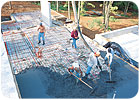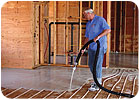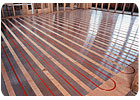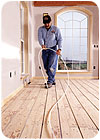The Wet and Dry of Radiant

A wet or ‘high mass’ radiant system refers to a system in which concrete or a gypsum-like surface is poured to encapsulate the radiant tubing destined to bring the heat. It’s the prevailing method for creating snowmelt systems. Photo courtesy of Watts.
While radiant heat of all kinds is all the rage these days, their methods of installation can sometimes get buried deeper than a PEX tube. Whether hydronic or electric, radiant systems generally heat from the ground up, through cables or tubing planted in, under, or on top of the floor. But there’s more than one way to get them there.

‘Wet’ hydronic systems are also used for space heating, being primarily installed as part of new construction. Photo courtesy of Hacker Industries.
Wet
The wet or “high mass” system is the older-and still popular-method of installation.
“Wet” refers to the concrete or the lighter-weight gypsum that is poured and spread over a wooden or cement sub floor. The poured concrete or gypsum underlayment encases a network of plastic or rubber tubes, which get stapled to the sub floor. This system is recommended for new construction where concrete is used to build the ground floor; ranch-style homes, which have no basements; and additions.
The added weight may necessitate additional floor support. And that extra layer can make efficient heating more challenging because the heat has to penetrate the concrete or gypsum encapsulating the radiant tubing and warm that up before any radiant heating of the room can take place.
For this reason, wood floors beneath thin carpeting or tile are recommended. Since it takes a while to heat up and cool down, the high mass system is less than ideal for areas that experience extreme temperature swings in short periods.

A dry or ‘low mass’ radiant system typically uses manufactured panels, such as the Uponor Quik Trak units shown here, into which the hydronic tubing is placed. Photo courtesy of Uponor.
Dry
A dry or “low mass” installation, with no poured floor, covers a variety of systems.
They can involve suspending radiant tubing underneath the sub floor between the joists or sandwiching the tubing between layers of plywood and, these days, it can also mean snapping the tubing into pre-fitted manufactured interlocking panels laid out over the building’s floor like a jigsaw puzzle.
Low mass systems are typically lighter in weight, less expensive, and able to heat and cool more quickly. A dry installation is a good choice for new construction and retrofits.

‘Dry’ hydronic systems, like the system using Rehau’s Raupanels shown here, are just what the doctor ordered for retrofit applications. Photo courtesy of Rehau.
Larry Drake, executive director of the Radiant Panel Association in Loveland, Colo., said all hydronic tubing products can be installed using either system, but the techniques vary just a little bit when using electric radiant systems.
“Electric system manufacturers are more specific about the installation of their products,” Drake said. “An electric heating element designed for a high mass system generally cannot be used in a low mass system without the manufacturer’s approval. There are electric products manufactured for low mass systems. The installer must check the manufacturer’s literature for the proper application.”
It is also recommended that whichever system is selected have the ability to convert to a different energy source.
The recent development of a plywood sub floor that is manufactured with built-in tubing grooves and aluminum heat diffuser plates promises more inexpensive installation with half as much tubing or cable.
"This article was originally posted on ww.reevesjournal.com."
"This article was originally posted on ww.reevesjournal.com."
Looking for a reprint of this article?
From high-res PDFs to custom plaques, order your copy today!






